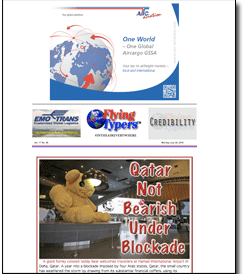A slower
than expected June is being followed by a
busier mid-summer for global air freight with
signs, that rates out of some Asian origin
hubs are now picking up, writes SkyKing.
 |
Late
July Surge
According to
Freightos, in late July, as container freight
rates were starting to surge ahead of the
peak ocean shipping season, air freight rates
remained, stable for a third straight week
although “promotional pricing is finally
taking off”.
“Most
years, promotions start in the early summer,”
reported the freight digitalization specialist.
“That’s
because airlines return larger planes to Europe
and add more flights catering to the increased
passenger demand. That boosts air freight
capacity too, but at a time when demand is
weak.
“There
weren’t any promotions earlier this
summer - with tighter capacity than previous
years, there was no need. However, they finally
kicked off two weeks ago, when several big
airlines began promotions.”
Freightos said
general and express rates on 26 July on the
China-U.S. lane were in the $2.90-6.0 per
kg range, on China-Europe they were fluctuating
between $2.80-6.0 per kg, while on on Europe-U.S.
the range was $1.60-3.0 per kg.
TAC
August Space Squeeze
TAC Index had
more specific lane pricing details, with Hong
Kong – Europe rates up to $2.88 per
kg on 30 July, a gain of 5.1% week-on-week,
but Hong Kong – North America rates
down 2.8% to $3.90 per kg.
In the first
week of August, space tightened ex-China and
rates were slightly higher ex-PVG, while the
Hong Kong-U.S. lane was picking up but no
backlogs were evident, according to Flexport.
Viet
Rate Rise
Ex-Vietnam was
a different matter. “Rates continue
to increase as demand, particularly to the
U.S. continues to rise. Demand ex-Vietnam
to the U.S. East Coast is especially high.
For any shipments with a strict deadline please
request express service,” the U.S.-based
forwarder advised.
Flexport also
predicted rates from Italy to the U.S. would
increase during the August summer holidays
and reported that ex-U.S. rates were climbing
with space into South East Asia and Mainland
China “very tight ex-LAX”.
Expectations
Sky High
“Air cargo
expectations are still high for the second
half and into the end-of-year peak season
as the strong demand seen in the first six
months is expected to continue,” it
added.
Despite the
rapid volume expansion experienced by air
freight stakeholders last year, 2018 has still
managed to yield healthy year-on-year cargo
growth on most trade lanes and, although the
myriad threats posed by the U.S. administration’s
tariff war could impact trade flows later
in the year, the outlook remains strong.
Carrying
Movement Forward
A host of forwarders’
second quarter results noted improving air
cargo volumes and returns, so it came as something
of a surprise to many when global volumes
of air freight as analyzed by WorldACD revealed
little year-on-year growth in June.
“It had
to happen one day, or rather one month,”
said WorldACD’s latest report. “June
2018 was that month: for the first time in
two years, air cargo's worldwide volume growth
stagnated as the year-on-year increase for
the month was a mere 0.4%.”
Hardly
End Of Days
As WorldACD
noted, however, it was hardly the End of Days
given that the first half of 2018 had yielded
impressive growth of 3.7%. “Our industry
is clearly divided when it comes to the prospects
for the second half of 2018,” it added.
“On the one hand, we read optimistic
prognoses from some of the big forwarders,
based mainly on what they see as a continuing
capacity squeeze. On the other hand, people
get worried about the future negative effects
of the trade policies - real or only tweeted
- of the unpredictable man in the White House.”

Take
Another Look
As a result,
concluded WorldACD, June results may not be
the best indicator for the rest of the year,
although it also noted that business from
Asia Pacific to the other regions declined
-0.1% in June compared to a year earlier,
and air cargo from the origins Africa, Europe
and the Middle East also contracted.
With reports
so mixed as to what impact tariffs had on
June figures – the first tranche of
U.S. tariffs on U.S. goods were imposed on
July 6– WorldACD also noted that exports
by air from China to the USA dipped considerably
in June.
“Although
this market had been sub-par for the full
first half year of 2018 already (-2.9% YoY),
the June figure of -5.9% YoY could be indicative
of a worsening climate between the two economic
powerhouses,” it added, although it
also made the valid point that China to Europe
was also negative in June (-2.9% YoY).
Polish
Up Your Crystal Ball
“Who is
to tell what results will be reported for
July onwards, when the first tariff increases
may start to bite. To us, the world of air
cargo looks fairly uncertain at the moment:
for once, to predict the future it may be
just as helpful to read the tea leaves or
to gaze into a crystal ball.”
Another risk
also looms over the second half of the year
for air freight, at least for those active
in U.S. markets.
As previously
reported in FlyingTypers, the repercussions
of the new electronic logging device (ELD)
mandate for trucks alongside driver shortages
continue to impact air cargo providers. “Higher
trucking rates, delays, and even modal switches
are some of the negative consequences for
air cargo,” said Flexport.
Hit
The Road Jack
With the 2017
capacity constraints for air freight still
fresh in the minds of forwarders and shippers
and many looking for guaranteed uplift space
throughout the year or chartering their own
planes, the squeeze in 2018, at least in the
U.S., could well come on the roads.
Booking capacity
early will be vital in Q4.
SkyKing
|




 Vol.
17 No. 46
Vol.
17 No. 46 Vol.
17 No. 47
Vol.
17 No. 47